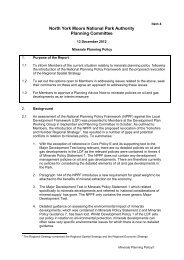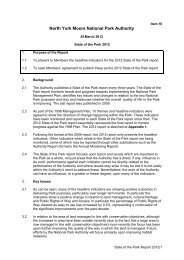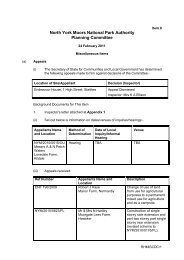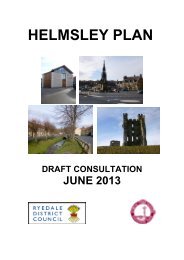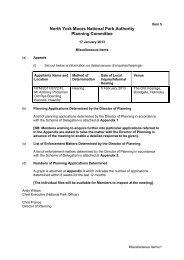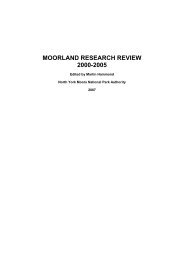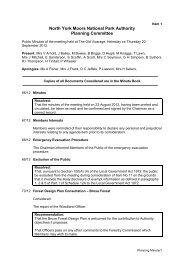Environmentcommon with some other upland areas these remains arenot buried and are therefore extremely vulnerable to surfacedisturbance.Over 800 monuments in the <strong>National</strong> <strong>Park</strong> have statutoryprotection as Scheduled Monuments, reflecting the nationalimportance of this resource. In fact 32% of the ScheduledMonuments in the <strong>York</strong>shire and Humber region are found inthis <strong>National</strong> <strong>Park</strong>. Of the Scheduled Monuments, 328 21 arecurrently judged to be at medium or high risk although workis being undertaken to address this through the Monument<strong>Management</strong> Scheme supported by English Heritage. Ofthese 328 there are 136 Scheduled Monuments as well as5 listed buildings identified in English Heritage’s Heritage atRisk Register 2011. This equates to 15% of all Heritage at Risksites in the <strong>York</strong>shire and Humber register. Understandingof the archaeological potential of the moorland has beensignificantly enhanced from the results of survey andresearch after an accidental fire on Fylingdales Moor in 2003.The historic landscape revealed by the fire included Neolithicrock art, bronze age burial mounds and cultivation remains,evidence of water collection and supply for the alum industryand Second World War slit trenches. All of these phases ofactivity survive side by side, providing a physical record ofsome 5,000 years of use.Although excavation is nowadays generally regarded asa last resort, carefully planned and targeted excavation isimportant for the advancement of archaeological knowledge,an effective mechanism for public participation and is ofconsiderable public benefit. Investigation has taken place atthe plough-levelled Iron Age promontory fort at Boltby Scar,as part of the Lime and Ice project, funded by the HeritageLottery Fund, to help the <strong>National</strong> <strong>Park</strong> Authority to betterunderstand and interpret the important prehistoric landscapeof the <strong>National</strong> <strong>Park</strong>’s western escarpment.The development of the <strong>National</strong> <strong>Park</strong>’s ArchaeologicalResearch and <strong>Management</strong> Framework has helped tofocus archaeological activity to provide answers to somelong standing questions. The Mesolithic project, involvingthe <strong>National</strong> <strong>Park</strong> Authority, Tees Archaeology and EnglishHeritage, is currently helping to re-evaluate the existingmodels of Mesolithic occupation, subsistence and chronologyin north east <strong>York</strong>shire. At the time of writing, an industrialarchaeology project is also being developed involving localcommunities, to focus on the importance of Grosmont andits associated rail links in fuelling the development of the ironindustry of north east England. It is recognised that furtherresearch is required to develop our understanding of how theearly ecclesiastical history of the <strong>National</strong> <strong>Park</strong> area is linked tothe origins and growth of our present villages.The Built EnvironmentThe built environment continues to form an essential partof the <strong>National</strong> <strong>Park</strong>’s appeal to visitors, combining with thelandscape to give the area its unique identity.The vernacular building style contributes significantly tothe overall character of the landscape. Stone and pantilesconstitute the vernacular building materials although Welshand some Westmorland slate began to be used from the mid19 th century. The built environment of the area reflects thegeology of the <strong>National</strong> <strong>Park</strong> with limestone the predominantbuilding material in the south and sandstone in the north. Thevernacular building form is the longhouse built using cruckconstruction. Although a large number of buildings haveundergone successive improvements and alterations, manycontain residual elements of earlier longhouses, for examplecruck frames in roof spaces. This vernacular has informed thedevelopment of farms, from simple linear farms to the moreloosely developed farmsteads that were added to cumulativelyduring the more prosperous farming periods, up to higherquality estate designed farmsteads.The area’s ecclesiastical heritage, including abbeys,monasteries, priories, nunneries and churches also plays anessential role in defining the character of the area. Whilst notcommon features in the landscape, there are a number ofcastles and similar structures, mostly around the edges of the<strong>Park</strong>, which provide an insight into the area’s diverse history.These include West Ayton, Whorlton, Helmsley and Danby.The reclusive, monastic tradition combined with coastalsmuggling heritage, small settlements, undeveloped moorlandand the echoes in the landscape of long abandoned industrialactivity creates an enigmatic atmosphere that has inspired along tradition of folklore and legend.The <strong>North</strong> <strong>York</strong> <strong>Moors</strong> has a relatively large number of ListedBuildings compared to other <strong>National</strong> <strong>Park</strong>s. 3,012 buildingsin the <strong>National</strong> <strong>Park</strong> are currently listed for their specialarchitectural or historic interest. Of these, 95 22 are on theAuthority’s Buildings at Risk register and five of the highestgradings are identified as being at high risk by English Heritage.The reasons for buildings falling into disuse and disrepairinclude their functional replacement by modern agriculturalbuildings, their remote and inaccessible locations and the21 As at May 201222 Annual Performance Report and <strong>Plan</strong> 2010 /11 (<strong>North</strong> <strong>York</strong> <strong>Moors</strong><strong>National</strong> <strong>Park</strong> Authority, 2011)26 www.northyorkmoors.org.uk
ability of owners to keep their buildings in good repair. Workis ongoing to reduce this number and in 2010/11, 11 buildingswere removed from the ‘at risk’ register. This was achievedthrough a mixture of re-assessment, historic buildings grant,enforcement action, planning approvals for change of use andowner action. Listed Buildings are an irreplaceable asset andmust be protected as an integral part of the cultural heritageand distinctiveness of the <strong>National</strong> <strong>Park</strong>.There are a variety of sources of funding available forimprovements to Listed Buildings in the <strong>National</strong> <strong>Park</strong> –the <strong>National</strong> <strong>Park</strong> Authority runs a Historic Buildings GrantScheme for buildings on the ‘at risk’ register and other sourcesof funding include the Landscape Intervention Fund andEnvironmental Stewardship. The <strong>National</strong> <strong>Park</strong> Authority alsooffers advice to owners wanting to make alterations or repairsto Listed Buildings. Partnership schemes in Staithes and RobinHood’s Bay have tackled a number of Buildings at Risk anddelivered significant enhancements to the public realm.Conservation of the historic environment often createsopportunities for enhancement which can facilitate theintroduction of viable new uses, having knock-on benefits forthe economy.detailing and materials of traditional buildings all contributeto the distinctive character of each Conservation Area. The<strong>National</strong> <strong>Park</strong> Authority has a duty to preserve or enhancetheir character and appearance through careful control ofnew development, and it has carried out pioneering workto help protect these Conservation Areas from erosion ofcharacter through the wide-scale introduction of Article4 Directions. This has brought in additional controls overalterations to features such as doors, windows, boundarywalls and gates in 38 Conservation Areas.The <strong>National</strong> <strong>Park</strong> Authority has a duty to publish proposalsfor the protection and enhancement of ConservationAreas. Conservation Area Assessments and <strong>Management</strong><strong>Plan</strong>s have been produced where necessary in responseto particular local issues and pressures. These identify thefeatures that contribute to the character of the area and setout how they will be maintained through managing changein a sympathetic way and securing improvements whereverpossible. Partnership working between various interestsincluding local communities, landowners, local historygroups, schools, English Heritage, Highways Authorities andthe <strong>National</strong> <strong>Park</strong> Authority is key to achieving improvementsin the historic environment.The quality of the <strong>National</strong> <strong>Park</strong>’s villages is outstandingwith Thornton-le-Dale a regular winner of the title ‘Britain’sPrettiest Village 23 . There are 42 Conservation Areas within the<strong>National</strong> <strong>Park</strong> which are designated because of their specialarchitectural and historic interest. The relationship betweenbuildings and spaces, traditional street layouts and the design23 www.enjoyengland.com<strong>North</strong> <strong>York</strong> <strong>Moors</strong> <strong>National</strong> <strong>Park</strong> <strong>Management</strong> <strong>Plan</strong>27




